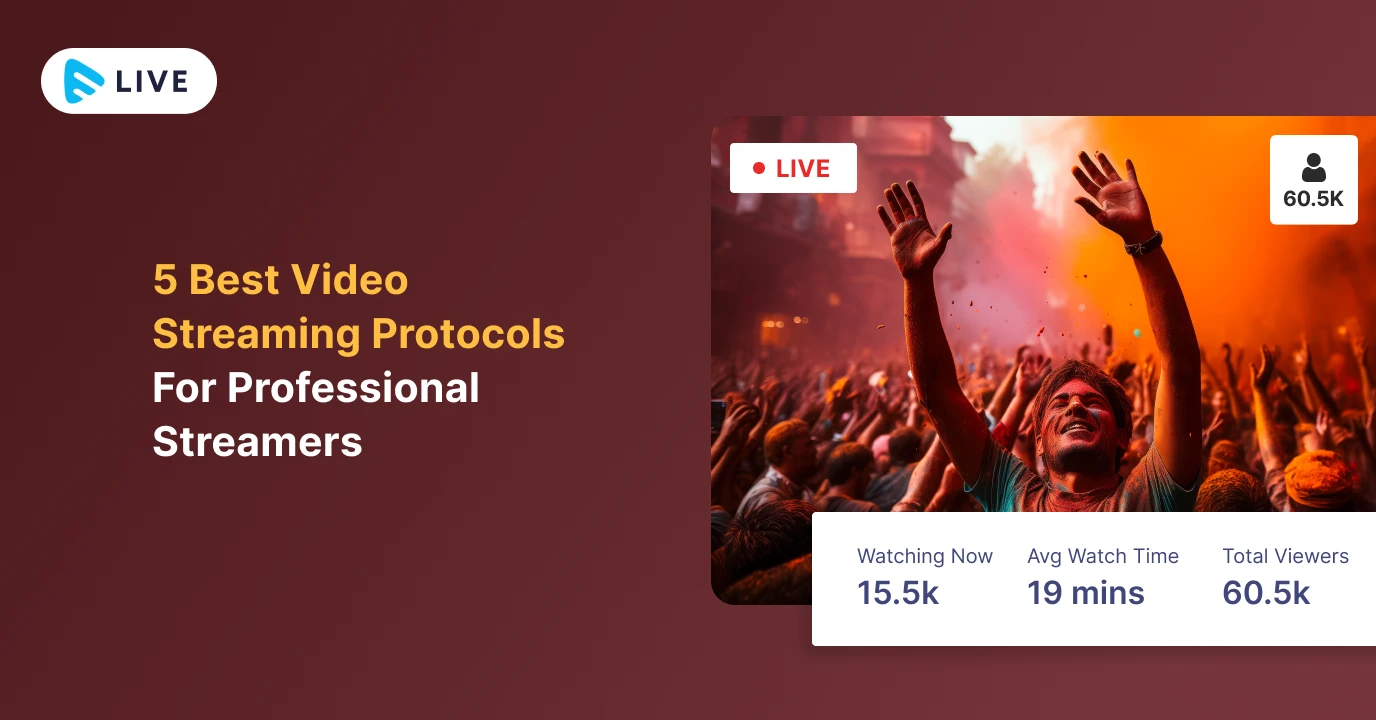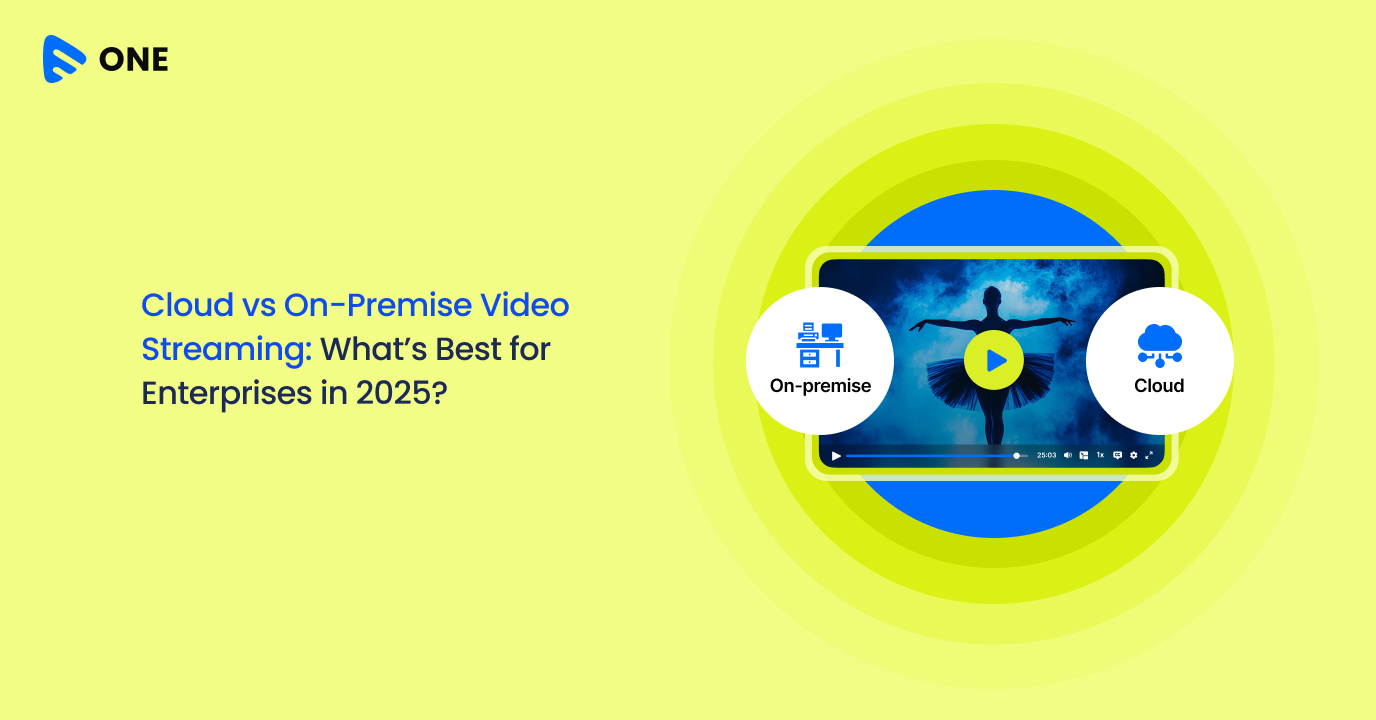Selecting the right video streaming protocol for your streaming needs can be a daunting task. Especially in today’s times when there are so many different options available to choose from, it makes it more difficult since different video streaming protocols come with their own set of advantages as well as limitations. Professional streaming today is a skillful combination of the right hardware, compatible streaming protocol, software optimizations, and much more. Every decision you make towards your professional live-streaming journey has to be carefully evaluated for its potential compatibility with all other parameters.
In this blog, we will discuss some of the best video streaming protocols to help you in this protocol selection process. All these protocols come with their pros and cons and we believe this blog will ultimately help you identify what video streaming protocol to choose.
What is a video streaming protocol?
A protocol is a set of rules that needs to be followed. Video streaming protocols are nothing but a defined set of rules that manage data communication from one system to another when a particular content is streamed. It is a standard method of breaking a video into small chunks, sending it to the viewer who requested it, and then assembling the information into the video file to be streamed on the device.
Essentially storage of video and playback on the same device is very different from streaming content and that is where these protocols come into place. Above is a simple explanation of how a protocol works but it gets complex as we move further.
A good video streaming protocol must also include adaptive bitrate flexibility to allow the best possible video quality to be streamed depending on the internet speed of the user. There are live-streaming events such as sports that require low latency in video playback so that sporting action is delivered in real time. A good video streaming protocol also includes provisions for low latency live streaming.
Understanding Widely Used Streaming Protocols
RTMP
Real-Time Messaging Protocol or RTMP is used for streaming video and audio files over the internet. It is one of the most widely used protocols that specializes in low-latency streaming requirements making it an ideal choice for live streaming content in a modified format.
History
RTMP was developed by Macromedia as a supporting tool for Flash Player. It was then acquired by Adobe which released a version of RTMP for public use.
Technology Glimpse
Mostly used for ingest live-streaming, RTMP requires a flash plugin to function that is not used anymore. It is therefore collaborated with other streaming protocols such as HLS to deliver video content. One of the most popular protocols of streaming in the early days, RTMP streaming today does not find many users owing to its dependency on Flash player that most browsers have stopped supporting.
Saying RTMP(FLASH) is dead may be right here but that does not mean we do not have any other applications of RTMP. Due to its low latency, RTMP Ingest is still considered as the best form for live streaming where RTMP encodes videos, and they are delivered using 3 simple steps.
- Handshake: This is step 1 of RTMP Ingest streaming where the client or the streaming software sends three data points. The first data point is to inform the server of the type of protocol for encoding and decoding of stream, the second one gives information about the timestamp and once both are received, the third data point establishes a connection.
- Connect: Communication is made between client and server in action message format (AMF) language.
- As soon as the handshake is complete and the client and servers are communicating, streaming can start as soon as you give a command.
This is known as RTMP Ingest where you use the RTMP protocol to encode data and transmit it to the users via some other protocol (usually HLS).
Pros Of RTMP Ingest
- Since RTMP streaming protocol is a low latency protocol, it becomes ideal for live streaming videos even in slow internet connections.
- RTMP streaming allows you to play, pause, and rewind content for the end user giving ease of entertainment.
- It supports multiple video and audio formats making it an ideal choice for various content producers.
Cons
- Since FLASH became obsolete, more and more browsers have stopped supporting RTMP making streaming using HTML5-based video players incompatible.
WebRTC
WebRTC or real-time communication can add interaction capabilities to your application supporting video and audio files. Giving flexibility to developers, WebRTC can be used to build powerful video applications and cloud phone systems, and since webRTC is open-sourced, it is supported by developers worldwide from Apple, Google, etc.
History
Developed by Global IP Solutions, it was acquired by Google in 2010 and post discussions with standard bodies at IETF and W3C, Google released a global open-sourced project called WebRTC for browser-based real-time communication.
Technology Glimpse
WebRTC uses JavaScript, APIs, and HTML to implement audio and video streaming by establishing a peer-to-peer connection thus minimizing the need for a centralized server for content delivery making it an ideal choice for video conferencing, video-based gaming, etc. It uses codecs like VP8, VP9, and H.264 for video and Opus, G.711, etc for audio transmission.
Pros
- Does not require additional plug-ins to establish communication.
- Backed by Google, major developers use this protocol to deliver communication making it a reliable choice that is constantly updated.
- Open-sourced so anyone can start using it to build applications that interact with browsers.
- Widely compatible with all major browsers.
Cons
- WebRTC being a P2P communication protocol requires every machine connected to another machine resulting in huge bandwidth consumption.
FTL
FTL or Faster Than Light protocol as the name suggests is a Microsoft-owned streaming protocol that deals with ultra-low streaming conditions and is a popular choice among industry-leading encoders such as XSplit and OBS Studio and comes pre-integrated with Windows and Xbox One machines.
History
Developed by the now-defunct streaming platform, Mixer (formally known as Beam) it was acquired by Microsoft. Mixer developed FTL to tackle the latency issue and focused on reducing it and enhancing interactivity between broadcasters and users. It was released as an open-sourced development package known as FTL SDK that encouraged experimentation from the streaming community.
Technology Glimpse
FTL starts with streaming initiation when a broadcaster starts streaming using a software encoder such as OBS Studio. The encoder captures video and audio and prepares it for transmission. The encoder then compresses the content using various codecs and then using peer-to-peer protocol it directly establishes a connection with the streaming platform without the need of an additional server.
Pros
- FTL offers ultra-low latency and this enhances interactive experiences such as gaming streaming.
- Open-sourced so anyone can start developing their own applications to interact with web browsers.
Cons
- Lower video quality.
SRT
SRT or Secure Reliable Transport Protocol has been around for around five years and since its inception is turning heads in the industry. SRT is built in a way to work on any network and bring the best live video quality over the worst of networks. According to Haivision, 53% of the OTT platforms use SRT for streaming its content.
History
Designed and deployed by Haivision, SRT was first publicly demonstrated in IBC, 2013 and since then the technology has progressed exponentially. Haivision released SRT on GitHub as an open-sourced technology stack in 2017 to make it more and more available for developers. Haivision was also awarded the prestigious EMMY award for its contribution to ease live streaming.
Technology Glimpse
SRT aggressively solves the latency issue and at the same time maintains live streaming quality. It is supported by AES 128/256-bit encryption and gives network health monitoring between endpoints. Using low-latency transmission techniques, it protects the stream against jitter, packet loss, and fluctuations. SRT operates at the network transport level wrapping the content. Thus it can transmit any type of video format and quality.
Pros
- SRT has an open-sourced code base making deployment costs lower than paid protocols.
- SRT can transmit 4K streams using professional grade encoder and decoder pairs.
Cons
- SRT still needs to find its audience as it is a comparatively new technology.
HTTP (HLS)
HTTP Live Streaming or HLS is an adaptive bitrate streaming communication protocol and is one of the most popular streaming protocols that combines HTML5-based video playback and produces one of the best live streaming experiences by dynamically adapting to network conditions depending on the connection speeds.
History
HLS was developed by Apple in 2009 and released as part of the iPhone OS enabling Apple devices to access live-streamed content across any unstable network conditions using adaptive bitrate technology. Due to its ease of use and support from the Apple community, HLS gained rapid popularity amongst streaming enthusiasts leading to its widespread adoption for streaming on Android devices, Apple devices, Smart-TVs, and so on. HLS has today become an industry standard in live streaming deployments.
Technology Glimpse
- HLS protocol cuts the video file into small chunks with a .ts file extension which is then stored on the HTTP server.
- An M3U* playlist file is created storing metadata such as duration, sequence, encryption details, etc.
- These short clips are then delivered to the user on their devices using the HLS Ingest protocol to transmit content to an HTML5-based video player post retrieving the M3U8 file.
Pros
- HLS has global compatibility making it a great choice for streaming if you’re looking for a single protocol that lets you stream quality content across multiple devices.
- HLS encodes the content in multiple quality settings enabling a smart selection by the protocol to stream the best-quality content based on internet speeds.
Cons
- Not designed for low latency streaming, it is not recommended for time-sensitive streaming.
Things To Consider Before Choosing The Right Streaming Protocol
So these were a few protocols that dominate the industry but the question remains the same, which protocol to choose? Our answer is still the same. It all depends on what type of content you wish to stream and where you wish to stream it. Here are a few parameters to consider while choosing the right streaming protocol.
Type of Content
Streaming time-sensitive content such as a live football game and streaming a movie both require different protocols for extracting the best. While live streaming will require a protocol that will require low latency so that minimal delays are observed, a movie can have latency and to be honest, there is no latency for movies after all.
Choose a low-latency protocol such as WebRTC for live streaming and HTTP-based protocols such as HLS for pre-recorded content.
Compatibility
Streaming for Netflix and streaming for Xbox are two different use cases. Always do a careful study of what platforms you wish to target and make an informed decision.
Scalability
Consider the scalability of the protocol to handle varying numbers of viewers. Some protocols and streaming solutions offer built-in scalability features or can be easily integrated with Content Delivery Networks (CDNs) for efficient content distribution.
Cost
The more you spend, the better technology you get. However, you should never underestimate the free protocols. It all depends on your use and your budget. Choose your technology wisely. Live streaming provider and OTT platform provider like Muvi help content producers develop applications and websites for their streaming needs.
Maintenance & Community Support
Evaluate the ease of implementation, development resources required, and ongoing maintenance efforts associated with the protocol or streaming solution. Consider the availability of community support, documentation, and professional support services for the protocol or streaming solution you choose.
Muvi Live: The Best Live Streaming Software
Planning to start your live streaming platform but confused about how to get started?
Muvi Live makes your live-streaming hassles go away. Built to suit beginners and at the same time provide enterprise-grade features, it enables you to live stream on all types of platforms and devices. From streaming sports requiring low latency to delivering video conferencing solutions, Muvi Live is the best choice for streaming professionals out there.
Features You Must Know
- Muvi Live is based on a pay-as-you-go model. This means users don’t need to pay any recurring subscription charges and pay only for what they consume in terms of bandwidth and streaming minutes.
- Users also get Meetings, a two-way group video meeting solution for your business.
- With built-in CDN, delivering buffer-free video has never been easier.
- Fully customizable HTML5-based video player and DVR-based live streaming to enable users to pause, rewind, and replay live streams.
- Start live streaming instantly using Live App for Android and iOS.
- Integrate live broadcasting capability or build a live streaming app from the ground up using a suite of SDKs and APIs for any platform.















Add your comment